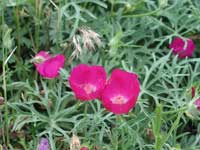Resource Library
Plant of the Week: Poppy Mallow
The University of Arkansas System Division of Agriculture does not promote, support or recommend plants featured in "Plant of the Week." Please consult your local Extension office for plants suitable for your region.
Plant of the Week
[A-Z]
Poppy Mallow
Latin: Callirhoe involucrate

As summer arrives most gardeners and most plants suffer burnout. Roasting in the heat is not much fun. But some plants, such as the tough poppy mallow (Callirhoe involucrata), not only take it but they seem to prefer it. Go figure.
Poppy mallow, also often called purple winecup, is a member of the heat-loving hibiscus family, the same family where notorious heat lovers such as cotton and okra belong. But instead of growing erect like most members of this family, poppy mallow is a sprawling perennial herb with a deep taproot. On the erosive soils of our central Oklahoma farm I once saw a pencil-sized poppy mallow taproot that went down 6 feet deep! On old plants, the top of the taproot can be 2 to 3 inches across. This species and C. pedata were eaten by Native Americans. The taproot is said to have a sweet potato flavor and texture.
Plants die back to the crown each winter but form trailing, 6-inch tall mounds of foliage by mid-spring. The leaves are usually deeply cut and form a kind of lacy veil over the ground.
The magenta-colored, five-petaled, 2-inch diameter flowers are cup-shaped and begin appearing in mid-spring and continue until mid-summer. The base of the petals fades to white. The stamenoid column, a feature of the hibiscus family, is shorter than many family members but still obvious. Flowers open during the day and close at night.
There are nine species of Callirhoe described with this species being the most common and widely distributed. While most are concentrated in the Southern Great Plains, C. involucrata ranges from Florida to Arizona and north to the Dakotas. Most species are sprawlers but one, C. digitata, is erect growing and can reach 5 feet tall.
The generic name was first used by Thomas Nuttall (1786 –1859), the English botanist who traveled into Arkansas and Oklahoma in 1819 but is better remembered for his travels in 1934 with the Wyeth expedition that opened the Oregon Trail. The name is probably derived from the name of the daughter of a classical Greek deity, Acelous, a river god. One author speculates it may be a corruption of a French name for the plant.
Winecup is typically found in rocky areas, along roadsides or in short grass prairies where its diminutive size is not a disadvantage. It is extremely drought tolerant once established and is well suited for use in rock gardens, as a groundcover in low maintenance flowerbeds or in xeriscape plantings. It can be interplanted with other low growing plants and bulbs to provide summertime color.
Winecup is tolerant of poor soils, even rather heavy clays, but requires good drainage. It should be planted in full sun. Plants are hardy from zones 4 to 9. Once established plants are difficult to transplant.
Cutting grown plants are available from nurseries or plants may be grown from seed. Seeds have a hard seed coat so before planting rub them between two pieces of sandpaper to break the seed coat. In the fall plant the seeds one half inch deep in the location where they are to grow. Germination will occur the following spring. Cuttings are made in early spring just as new shoots are emerging from the crown.
By: Gerald Klingaman, retired
Extension Horticulturist - Ornamentals
Extension News - July 25, 2008
The University of Arkansas System Division of Agriculture does not maintain lists of retail outlets where these plants can be purchased. Please check your local nursery or other retail outlets to ask about the availability of these plants for your growing area.